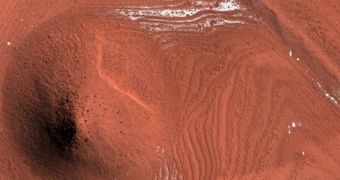NASA's Mars Reconnaissance Orbiter has captured amazing new images that show an odd feature on the northern pole of the planet. It seems to be an impact crater, which was revealed as the terrain in the region slowly eroded.
The characteristics of the red planet all indicate evidence of a violent past, like the fact that its magnetic field is concentrated in the southern hemisphere. The layered deposits from Mars' northern polar cap, which are several kilometers thick and filled with water ice, – also known as Planum Boreum – were recently photographed by the MRO's High Resolution Imaging Science Experiment (HiRISE) camera. They contained a small (40-meter or 130 foot-tall) hill-like lonely mound lying on the downside of a 500-meter (about 1,650 feet)-wide erosion slope.
HiRISE expert Shane Byrne from the University of Arizona stated that, “The mound may be the remnant of a buried impact crater, which is now being exhumed.” This is not quite how you'd expect a crater to form, but a possible theory says that, as the layers deposited, they were affected by smashing meteorites, and the emerging craters were later covered by ice. There is a real possibility that there are many such craters hidden beneath the surface of the planet's pole.
The fact that the erosion formed a trough above and around the crater, exposing it for the MRO to shoot it, is a lucky event. “For reasons that are poorly understood right now, the ice beneath the site of the crater is more resistant to this erosion, so that as the trough is formed, ice beneath the old impact site remained, forming this isolated hill,” explains Byrne.
A smaller impact crater of only 115 meters (125 yards) diameter was also photographed by MRO in the north polar region. The presence of such features might mean that the cap on the north pole may be only about 100,000 years old, accumulating only few such impact evidences, or that perhaps that ice covers the craters as it is becoming more lax. Further analyses and observations will hopefully shed more light on the subject.

 14 DAY TRIAL //
14 DAY TRIAL //